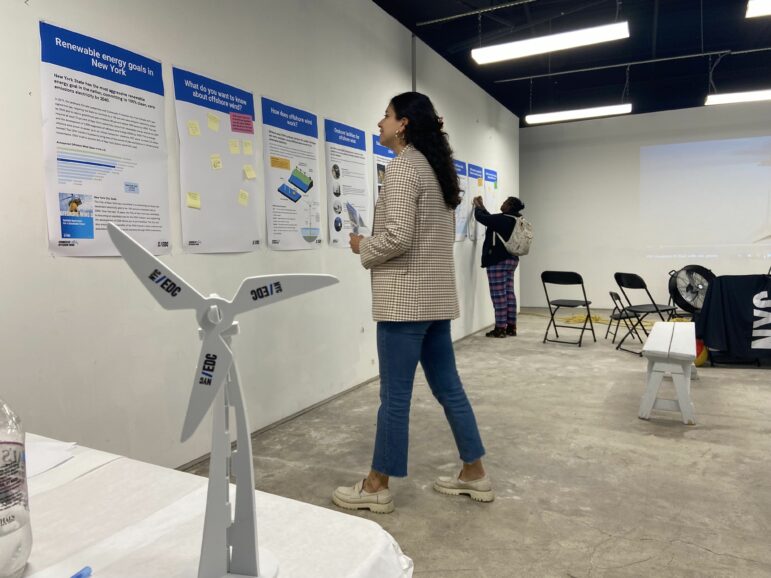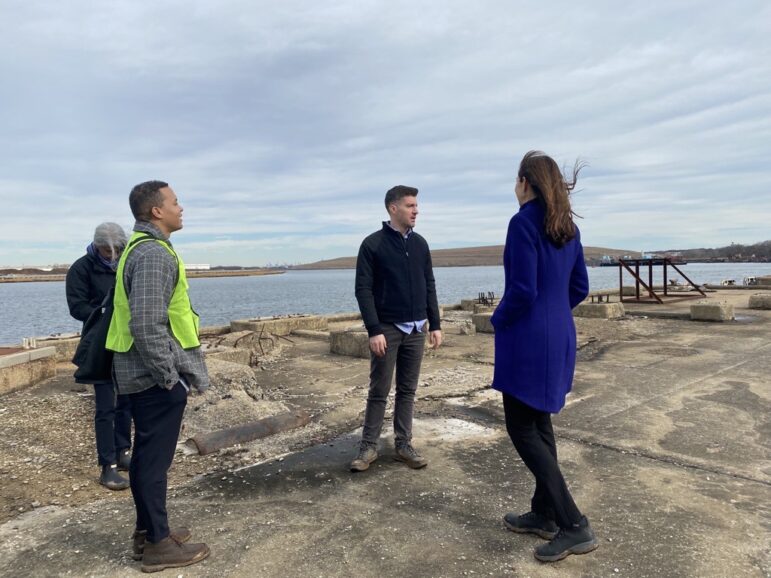With three large-scale waterfront industrial properties—Arthur Kill Terminal, Staten Island Marine Terminal, and Rossville Municipal Site—under consideration for offshore wind development, thousands of jobs could soon be washing up on Staten Island’s shores.

Mary Cunningham
NYCDEC held a “Summer of Offshore Wind,” event series inside the Staten Island Ferry terminal to educate and engage residents as the borough emerges as a hub for the industry.Staten Island commuters came face to face with the future of renewable energy as they descended from the ferry on a recent Friday afternoon.
Representatives from New York City Economic Development Corporation (NYCDEC) were inside the terminal to greet passersby, handing out flyers and inviting them to visit a pop up on offshore wind. Guests had a chance to read about how offshore wind works, “climb” a wind turbine using a virtual reality headset, and learn about how to get involved in the burgeoning energy sector.
The programming is a part of NYCDEC’s “Summer of Offshore Wind,” an event series designed to educate and engage Staten Island residents as the borough emerges as a hub for the industry, and as the state works to transition its energy sector away from fossil fuels.
“We want to make sure Staten Islanders understand the volume of activity and interest in offshore wind as it pertains to the island and that they understand the opportunities, both existing and to come, that go hand in glove with this industry,” said Nse Esema, vice president of the smart sustainable cities team and co-lead of offshore wind efforts at NYCEDC.
With three large-scale waterfront industrial properties—Arthur Kill Terminal, Staten Island Marine Terminal, and Rossville Municipal Site—under consideration for offshore wind development, thousands of jobs could be washing up on Staten Island’s shores in the coming years, of an estimated 10,000 statewide.* At least two of those sites were proposed for industrial use by developers as part of New York State’s third offshore wind competitive solicitation, with the winning bids to be announced sometime this summer.
“These are properties that really haven’t found a purpose,” said Councilmember Joseph Borelli, who represents the island’s south shore. “Now to have an industry that is going to bring thousands of jobs for 25, 30 years is, pardon the pun, but a windfall for Staten Island.”
Staten Island wind potential
Staten Island, with its strong existing maritime infrastructure and waterfront access, is fertile ground for offshore wind developers to plant roots. Large vessels will easily be able access ports, where they can transport materials needed to build wind farms.
Wind farms usually take two to three years to complete and require a wide range of equipment including turbine foundations, turbine towers, generators, and blades, said Boone Davis, president and CEO of Atlantic Offshore Terminals, the developer for Arthur Kill Terminal. Wind turbines are massive in scale; the blades alone can be longer than the size of a football field.
Arthur Kill, a 32-acre expanse of land nested under the Outerbridge Crossing, is one of the Staten Island sites that could be used to assemble wind turbine materials.
“The goal is to do as much work as possible onshore, to reduce the amount of time it takes to actually complete the installation work offshore, thereby reducing costs,” Davis said.
Atlantic Offshore Terminals plans to transform Arthur Kill into a “construction hub” for offshore wind in the coming years. The developers hope to start construction by the end of this year and to open the facility’s doors in January 2026. Once completed, it will primarily service wind farms in New York state, but will likely end up supporting projects in other states too, said Charles Dougherty, the company’s chief commercial officer.
The other two sites on Staten Island being considered for development—Rossville and Marine Terminal—would likely be used as either offshore wind manufacturing sites or assembly facilities similar to Arthur Kill, according to Esema at NYCEDC.
In December 2022, the development corporation awarded NorthPoint Development as a conditional developer for Rossville and recently issued a request for proposals for the site.
Community buy-in
With all of this change on the horizon, there is talk about how offshore wind development might impact coastal communities.
A new report from Regional Plan Association (RPA) and Karp Strategies says that offshore wind developments slated for New York and New Jersey will require at least eight transmission pathways through communities such as Sunset Park, Brooklyn.
The pathways—which consist of cables, converters and substations—transfer energy generated from wind turbines from the ocean to the electric grid on land. The construction of these pathways will lead to temporary disruptions such as road closures, making community engagement and buy-in all the more important.
“The success of offshore wind hinges on authentic community and economic development partnerships with the coastal neighborhoods that will be most immediately impacted,” Rebecca Karp, founding principal and CEO of Karp Strategies, said in a statement.
If approved for offshore wind use, the Staten Island sites themselves will require approval at the city, state, and federal levels, a process that includes public comment.

NYCEDC
EDC officials at the Rossville Municipal Site, which the agency aims to transform into an off shore wind port facility.Councilmember Borelli expressed concerns about how construction might impact noise levels and traffic patterns in his district. Still, the projects have his unwavering support.
“I am doing everything possible to make sure that these companies get what they need to begin operating,” he said.
More jobs on the horizon
The development of these facilities and new wind farms around the state—like the South Fork site on Long Island—mean more job prospects for Staten Island residents.
NYCEDC projects that the offshore wind industry will employ up to 13,000 New Yorkers in the next 15 years and generate a supply chain of $109 billion for the east coast. The jobs will cover a multitude of industries from construction, to manufacturing, to engineering.
Dougherty of Atlantic Offshore Terminal estimates that Arthur Kill Terminal will employ somewhere between 500 to 600 construction workers who will help with pile driving, dredging, carpentry, and electrical cabling. “This will be a fully union job,” he said.
Once the facility is up and running, they will also need people to load and unload ships, operate vessels, and assemble and test the wind turbines, Davis added.
Multiple groups are already strategizing on how to make sure these jobs go to Staten Island residents.
Linda Baran, president and CEO of the Staten Island Chamber of Commerce, pointed out that locals are usually saddled with long commutes off the island, and that this is an opportunity to create jobs right in their backyards. The chamber is actively working to figure out how small businesses can plug in and prepare workers for future job opportunities.
“For us it’s just trying to figure out, what are these jobs, where are jobs, and how do we really make sure that the community benefits from it?” Baran said.
NYCEDC reports that maritime businesses on Staten Island such as Miller’s Launch, Great Lakes Dredging, and Kirby Marine Services, are already securing contracts to provide vessels and transportation services.
Developers will also be leaning on the expertise of local engineers as they build out the state’s offshore wind capacity. That’s where schools like the College of Staten Island (CSI) come in. The college, part of the City University of New York, recently received $566,000 in state funding to help train the next generation of professionals for careers in offshore wind.
The funding is being used to buy new equipment and build a renewable energy systems laboratory for the school’s Engineering and Environmental Science Department.
With these new resources available, students at CSI will gain the theoretical and practical skills needed to work as electrical engineers, mechanical engineers, geologists, and more, said Vinay Vaishampayan,* a professor of electrical engineering at the college.
CSI is part of a CUNY offshore wind advisory network alongside Kingsborough Community College, New York City College of Technology, and LaGuardia Community College.
“This advisory network is introducing the community and a large part, the high school students, into the future of the economy here in the region,” said Robert Wallace, interim vice president of economic development and community partnerships at the college.
Part of a larger state and country-wide effort
The United States currently has seven offshore wind turbines: five off of the coast of Rhode Island and two off the coast of Virginia. But more are on their way: the Biden administration has set a goal to reach 30,000 megawatts of offshore wind capacity by 2030.
New York will be a major player in helping the nation reach this target. In 2019, the state, through the Climate Leadership and Community Protection Act (CLCPA), set a target to develop at least 9,000 megawatts of offshore wind by 2035—enough to provide about 30 percent of the state’s total energy supply, according to Gregory Lampman, director of offshore wind at New York State Research and Development Authority (NYSERDA).
Five offshore wind projects around the state are currently in development and will help the state hit 4,300 megawatts—about halfway to its goal. New York City, in partnership with NYCEDC, has outlined its own plans in a $191 million offshore wind vision.
As the industry takes off across the state, Staten Islanders are looking ahead, excited to see how it will impact their home turf.
“Ultimately, it’s a positive outlook that we have a world class industry knocking on our door,” said Councilmember Borelli. “That’s something that doesn’t happen every day in Staten Island.”
*A previous version of this story incorrectly identified the source who provided information about the College of Staten Island’s plans. This piece has also been updated to correct the estimated number of local jobs the offshore wind industry is expected to bring. City Limits apologizes for the errors.









One thought on “The Offshore Wind Industry is Knocking on Staten Island’s Door”
This article is a fascinating wealth of interesting and well-written useful information. I commend your hard work on this and thank you for this information. I know very well that if anyone visits your blog, they will definitely revisit it again.